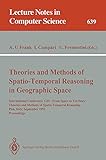Theories and Methods of Spatio-Temporal Reasoning in Geographic Space [electronic resource] : International Conference GIS — From Space to Territory: Theories and Methods of Spatio-Temporal Reasoning Pisa, Italy, September 21–23, 1992 Proceedings / edited by A. U. Frank, I. Campari, U. Formentini.
Material type: TextSeries: Lecture Notes in Computer Science ; 639Publisher: Berlin, Heidelberg : Springer Berlin Heidelberg, 1992Description: XIII, 439 p. online resourceContent type: text Media type: computer Carrier type: online resourceISBN: 9783540473336Subject(s): Computer science | Data structures (Computer science) | Database management | Artificial intelligence | Computer graphics | Optical pattern recognition | Computer Science | Database Management | Artificial Intelligence (incl. Robotics) | Computer Graphics | Data Structures | Data Storage Representation | Pattern RecognitionAdditional physical formats: Printed edition:: No titleDDC classification: 005.74 LOC classification: QA76.9.D3Online resources: Click here to access online
TextSeries: Lecture Notes in Computer Science ; 639Publisher: Berlin, Heidelberg : Springer Berlin Heidelberg, 1992Description: XIII, 439 p. online resourceContent type: text Media type: computer Carrier type: online resourceISBN: 9783540473336Subject(s): Computer science | Data structures (Computer science) | Database management | Artificial intelligence | Computer graphics | Optical pattern recognition | Computer Science | Database Management | Artificial Intelligence (incl. Robotics) | Computer Graphics | Data Structures | Data Storage Representation | Pattern RecognitionAdditional physical formats: Printed edition:: No titleDDC classification: 005.74 LOC classification: QA76.9.D3Online resources: Click here to access online  E-BOOKS
E-BOOKS
| Current library | Home library | Call number | Materials specified | URL | Status | Date due | Barcode |
|---|---|---|---|---|---|---|---|
| IMSc Library | IMSc Library | Link to resource | Available | EBK6053 |
Do people understand spatial concepts: The case of first-order primitives -- Temporal databases -- People manipulate objects (but cultivate fields): Beyond the raster-vector debate in GIS -- Time and space:An economic model -- The changing language of and persisting patterns in the urban design of Edo/Tokyo -- Toward a behavioral theory of regionalization -- Descriptive modeling and prescriptive modeling in spatial data handling -- The geometry of environmental knowledge -- Spatial reasoning using symbolic arrays -- Using orientation information for qualitative spatial reasoning -- The observer's point of view: An extension of symbolic projections -- Reasoning about gradual changes of topological relationships -- The meaning of “neighbour” -- A hierarchical triangle-based model for terrain description -- A model for expressing topological integrity constraints in geographic databases -- Encoding spatial information: The evidence for hierarchical processing -- Is there a relationship between spatial cognition and environmental patterns? -- Counter-intuitive geographic ‘facts’: Clues for spatial reasoning at geographic scales -- Spatial-linguistic reasoning in LEI -- User models and information theory in the design of a query interface for GIS -- A conceptual model of wayfinding using multiple levels of abstraction -- Towards acquiring spatio-temporal knowledge from sensor data -- Automatically acquiring knowledge by digital maps in artificial intelligence planning techniques -- Machine induction of geospatial knowledge -- Treatment of qualitative geographic information in monitoring environmental pollution.
This volume collects the papers presented at the first international conference dedicated to spatial and temporal reasoning in geographic space, entitled "GIS: from space to territory - theories and methods of spatio-temporal reasoning". Within the National Center for Geographic Information and Analysis (NCGIA, one of the supporters of the conference) the importance of spatial and temporal reasoning was recognized several years ago. Initial research found that spatial reasoning in geographic or large-scale space is different from spatial reasoning in small-scale space, as usually dealt with in robotics and expertsystems. Temporal reasoning has attracted interest in the artificial intelligence community. The volume also includes two invited papers: "Do people understand spatial concepts: the case of first-order primtives" by R.G. Golledge, and "Temporal databases" by R.T. Snodgrass.


There are no comments on this title.